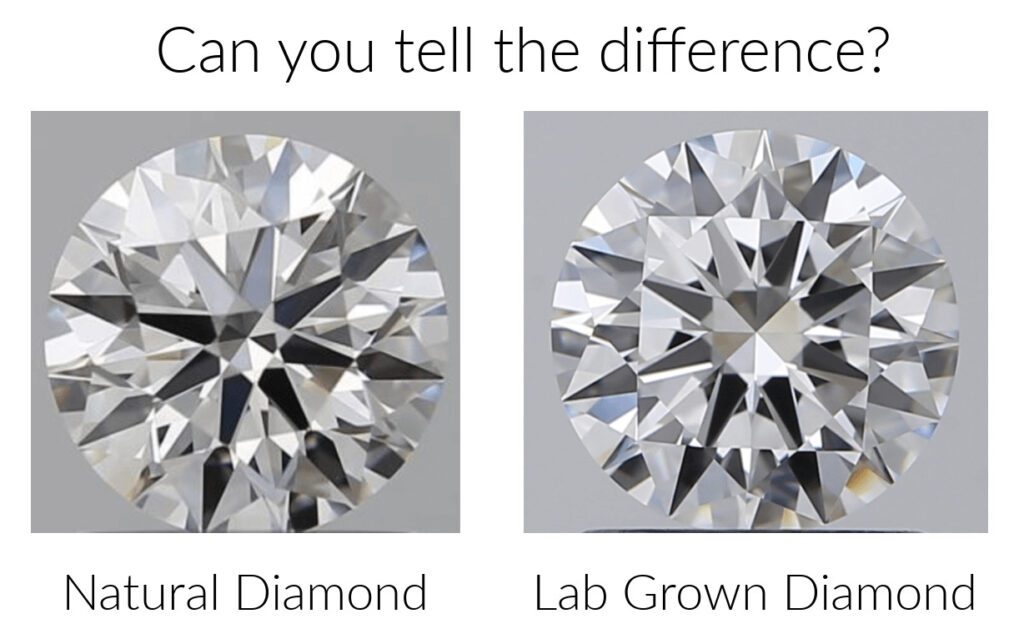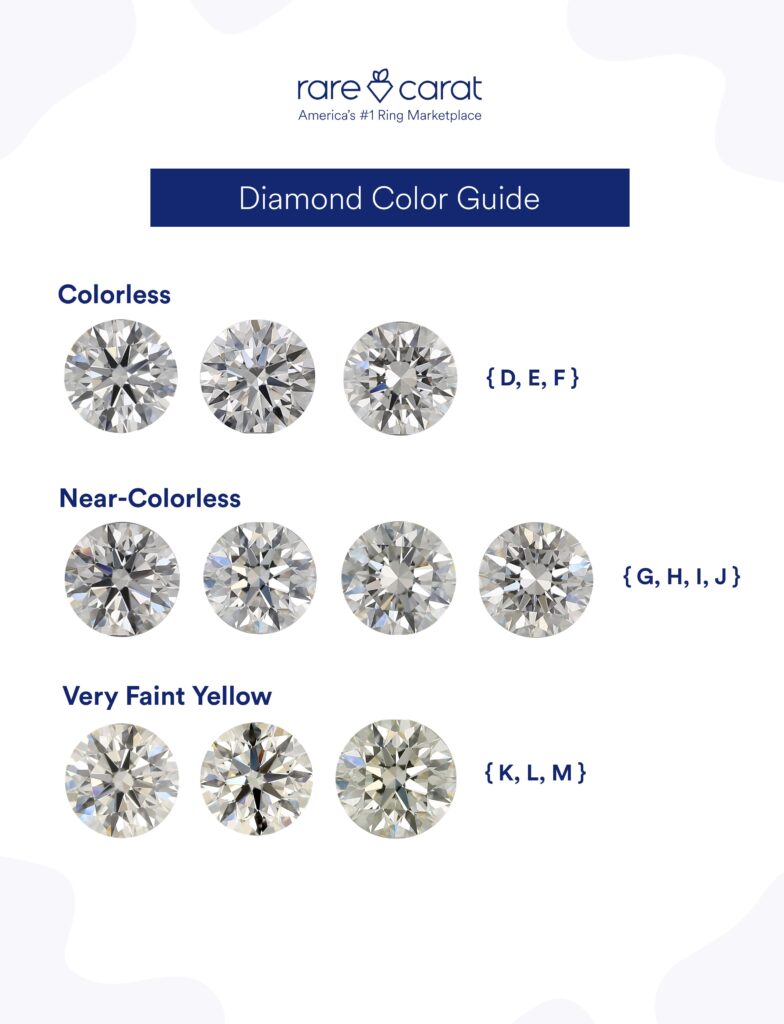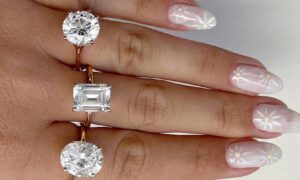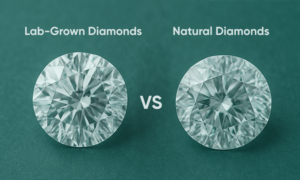Lab Grown Diamonds vs Real Diamonds for Engagement Rings
Diamonds symbolize wealth and luxury, and are worn by many as a status symbol. When proposing for an engagement or marriage, they are usually used to express love, happiness and commitment. These are just a few reasons why diamonds are the go-to rocks for most engagement rings.
However, they are also quite costly. Acquiring diamond is such a huge investment, especially if it’s a real diamond. For one, there’s a limited supply of these gems. That, combined with the fact that it costs a lot to bring diamonds to the market, makes them too expensive for many. The good news is that you have an alternative in the shape of lab grown diamonds.
If you’re looking for a diamond ring at a friendly budget, try shopping in the synthetic diamond section. These man-made diamonds are growing in popularity because they are affordable yet offer comparable qualities to real diamonds. On this page, we compare lab grown diamonds vs real diamonds to help you pick that perfect rock for your loved one without spending an arm and a leg.

What is a lab grown diamond?
Lab-grown diamonds are made in a lab through the process of diamond synthesis. Historically, real diamonds were the most used gems for celebrating engagements and marriages. But their limited supply, coupled with the high cost of mining and production, has paved the way for man-made diamonds.
Lab-grown diamonds have only been on the market for a few years, but they are quickly gaining in popularity due to their many advantages over real diamonds. They are made through two major processes. The first is high pressure, high temperature (HPHT) and the second is chemical vapor deposition (CVD).
- High temperature (HPHT)
This is a process of making diamonds that began back in the 1950s. HPHT creates an environment that simulates the conditions of the earth. It uses high pressure and heat to mimic the process by which real diamonds are formed. These temperatures can go as high as 2,600 degrees Celsius, an imitation of the heat in the earth.
After this transformation the diamond pieces can be altered to many color types. Some of them include: blue, pink, colorless, yellow or even canary colors. The close resemblance of HPHT diamonds to real diamonds makes it difficult to differentiate them.
Here’s a summary of the steps involved in the creation of lab-grown diamonds using the HPHT method:
- A small diamond seed is placed in a special reactor and covered with carbon-rich gas, such as methane or hydrogen.
- The gas is then subjected to high temperatures and pressures, mimicking the conditions deep underground where diamonds are formed naturally.
- As the carbon atoms build up around the seed, they form a rough diamond crystal.
- Once the diamond is grown to the desired size and quality, it is cut and polished just like a natural diamond.
- Chemical vapor deposition (CVD)
CVD, on its part, uses a vaporized carbon source that deposits diamond crystals onto a substrate. Through this method, lab-grown diamonds can be produced to match the chemical, optical, and physical properties of real diamonds, making it difficult to tell the difference between the two. The used to make lab grown diamonds using CVD are:
- A small diamond seed is placed in a vacuum chamber.
- A gaseous mixture of carbon-containing compounds, such as methane or hydrogen is introduced into the chamber.
- The gasses are then subjected to a plasma, which breaks down the molecules and deposits them onto the diamond.
- As the carbon atoms build up around the seed, they form a rough diamond crystal.
- Once the diamond is grown to the desired size and shape, it is cut and polished just like a natural diamond.
Is a lab grown diamond a real diamond?
Yes, lab grown diamonds are 100 percent real and authentic. Although they are man-made, synthetic diamonds have the same physical and chemical properties of real diamonds.
Since they are real diamonds, lab-grown diamonds provide a sparkle, brilliance, shine and beauty of a mined one, but at a budget-friendly cost. Overall, lab-grown diamonds cost 30% less than real diamonds.
What is a real diamond?
A real diamond is a diamond that occurs through a natural process. It is formed over time, deep within the earth, under conditions of high pressure and heat. This process can take millions of years to complete. Nonetheless, the extreme pressure and heat deep within the earth is what turns carbon into diamonds.
Real diamonds are mined from kimberlite pipes, which are deep shafts in the earth that were once volcanoes. Diamonds formed within the earth undergo the following natural process:
- Melting of carbon molecules in the earth’s mantle.
- Pressure and intense heat transform the pure carbon into a solid stone that floats towards the surface.
- Over time, erosion exposes the diamond on the surface where it can be mined.
- Once it is mined it is taken to a jeweler where it is cut and polished to be used in jewelry.
Differences between Lab grown diamonds and real diamonds
While they are similar in many ways – especially in their shine – lab grown diamonds and real diamonds have some differences. Both have their own unique benefits and drawbacks that are worth keeping in mind when shopping for an engagement ring. Below we compare lab grown diamonds vs real diamonds to help you pick the perfect engagement or marriage stone.
How they are made and extracted
Lab grown diamonds are created in a lab through the process of diamond synthesis. It involves the use of both heat and pressure to simulate suitable conditions to encourage formation. This process can take weeks or even months, depending on the size and quality of the stone you are trying to create.
On the other hand, the occurrence of real diamonds greatly depends on natural earth processes. These can take millions and millions of years to form. The current sources of real diamonds on earth were formed during the earth’s formation process.
Perhaps the biggest drawback to natural diamonds is their extraction process. It typically takes a lot of energy, manpower and resources to mine and refine real diamonds. Destruction and degradation of the environment is also a byproduct of such activities.
The same can’t be said about lab-grown diamonds, which are usually created in controlled environments using technology. That said, real diamonds can have unique features that make them more desirable. For example, some stones have a few impurities that make them sparkle with different colors.
Color
The color of a diamond is very important, with pure white being considered the ideal gem. Lab grown diamonds colors can range from perfectly colorless to a light yellow. Other colors that can be made include: canary colors, blue and pink. Regardless of the color you choose, lab grown diamonds are cheaper than natural diamonds, so those on a budget can still enjoy the beauty of this gemstone.
Natural diamond colors are usually measured using the GIA color scale that ranges from D to Z, with D being colorless and Z being yellow or brown. Generally, D-E-F are the most valuable. However, G-H-I colors are still considered white to the naked eye. J-K-L colors will be slightly visible to the naked eye, and anything lower than that is considered yellow or brown in color.

Clarity
Lab-grown diamonds are often produced to have fewer inclusions and blemishes, which means they are typically clearer than their natural counterparts. However, makers can still add natural inclusions to make lab grown diamonds more similar to real diamonds. The more inclusions a stone has, the lower its clarity rating will be.
Generally, real diamonds have a clarity level of VS-2 or better. Thus, when shopping for a lab grown diamond, you may want to choose a stone that matches or exceeds that clarity level.
The laboratory grown diamonds sold by Rare Carat have the same optical, physical, and chemical properties as real diamonds. The only difference is that our diamonds are created in a laboratory environment. At any grade, clarity is not the most important characteristic that makes a diamond precious.
Durability
One of the biggest draws to lab grown diamonds is their durability. They can go for centuries without wear and tear because their hardness is close to that of natural diamonds. They are also scratch resistant and do not require extra care to keep them looking lustrous. That’s why many sellers of lab grown diamonds offer trade-in and buy-back guarantees for their products.
That said, the durability of real diamonds is unrivaled. They are the hardest natural substance on earth and will not scratch or chip easily. Natural diamonds also do not require extra care, just routine cleaning with soap and water or a commercial jewelry cleaner.
So, if you are looking for a diamond that will last a lifetime and beyond, then a natural diamond is probably your best bet. Of course, you will need to have the budget for it. Otherwise, a lab grown diamond may well be a better option if you are working on a budget. It will give you almost the same durability.
Price
Lab-grown diamonds are a great choice if you want to save money. In fact, lab grown diamonds are typically 20-30% cheaper than real diamonds, making them a more affordable option for those on a budget. You may choose to go easy on the budget for purchase and save the money for something else – like the wedding.
Factors such as supply of the resources directly influences the price flux. For real diamonds, since it takes billions of years for them to form. The natural supplies deep within the earth creates a limit in supply. This fact will drive the price of real diamonds upwards as that of lab grown diamonds declines.
Resale value
When it comes to the resale value, natural diamonds and lab grown diamonds have different prices. Most natural diamonds will keep up to 50% of their initial value. However, with lab grown diamonds it is hard to resell. The possibility of accepting pennies on the dollar is inevitable. A huge percentage of value is lost as soon as you buy it.
Besides, the supply of lab grown diamonds keeps growing as that of real diamonds declines. The laws of economics dictate that prices will generally rise with decreasing supply and reduce with an increase in supply. Thus, there’s every possibility that the resale value of real diamonds will continue to rise because of their limited supply as that of synthetic diamonds declines because of their increased supply. Ultimately, people will opt to buy new lab grown diamonds rather than buying them second hand.
What should you choose between Lab grown and Real diamonds?
When all is said and done, the lab grown diamonds vs real diamonds debate comes down to what you should choose for an engagement ring. The thing to keep in mind is that there are several similarities between lab-grown diamonds and genuine diamonds. They have the same chemical structure, with each diamond made of a single element: carbon. Lab-grown diamonds and real diamonds refract light in the same way, disperse light in the same way, and have the same luster.
Because of these similarities, there are a few key reasons why you might want to choose a lab grown diamond ring over a real diamond ring. Firstly, lab grown diamonds are more eco-friendly and conflict-free, as they are not mined from the earth. They do not require the mining of fossil fuels and other minerals, which can have a negative impact on the environment.
Also, real diamonds are rare in occurrence and their natural sources might deplete. Many people who choose lab grown diamonds are aware of this. That’s why they stay aware from natural diamonds as a way of conserving natural resources.
Beyond that, lab grown diamonds may be created in a wide range of colors and sizes, making them more customizable. Plus, they are usually less expensive than real diamonds – up to 30% less costly. Therefore, if you are working on a budget, it makes more sense to buy a lab grown diamond.
How to buy lab grown diamonds
Shopping for lab grown diamonds can be a different experience than shopping for real diamonds, as they are not as widely available. To make your work that bit easier, Rare Carat can help you compare lab grown diamonds vs real diamonds. You can also compare various types, sizes and shapes of lab grow diamonds as you try to find the perfect stone for your loved one.
With an easy-to-use search tool, Rare Carat allows you to find Lab Grown Diamonds from a variety of different retailers and compare prices, carat weight, cut, color, and clarity. To start your online shopping on the Rare Carat website, do the following
- Go to the website: https://www.rarecarat.com/
- Click on the “Loose Diamonds” or “Lab-Grown Diamonds” option to explore the wide selection of diamonds available on the site.
- Select your desired diamond based on its carat weight, cut quality, color, and other factors.
- Add the diamond to your shopping cart and checkout.
- Enter your shipping information and choose a payment method.
- Wait for your beautiful diamond to arrive and enjoy wearing it for many years to come!
In addition, Rare Carat Augmented Reality (AR) technology uses your phone to virtually try on diamond rings, so you can be sure that the ring you choose is exactly what you want. You also have access to high quality imagery and 360 product videos to enhance visualizations.
The range of choices displayed on the site are unlike anything else in the jewelry industry. So, whether you’re a Lab Grown Diamonds expert or just getting started, Rare Carat is the perfect place to shop for your next diamond ring.
Firstly, Rare Carat can customize the setting on your diamond. As buyer Steve explains “I purchased my ring from RareCarat last year. I got the best price for a 1 carat stone and asked them to custom make the setting. They were very communicative and offered suggestions along the way. I highly recommend them.”
Secondly, Rare Carat offers you a beautiful diamond at your price range. As buyer Mason narrates “I worked with RareCarat to find a loose diamond for an engagement ring. I found the experience to be much better than going into a jewelry store. The prices were great and their customer service was excellent. I highly recommend them for anyone looking for a diamond.”
Thirdly, the customer service at Rare Carat is very thorough, giving you information to help your decision making. As buyer Noelle stated “I was really impressed with the selection of stones that RareCarat has available. I purchased a beautiful half carat diamond for an engagement ring and got it set in the style that I wanted. The whole process was very easy and their customer service was great.”
In conclusion
Despite their similarities, real and lab-grown diamonds do have some key differences, especially in price. Lab-grown diamonds are typically less expensive than real diamonds. In addition, they also tend to be purer, with fewer impurities and blemishes.
While Lab-grown diamonds certainly have some benefits, there are also downsides. Lab-grown diamonds can be less durable than real diamonds, and they may not hold up as well over time. Additionally, the resale value of lab-grown diamonds is typically lower than that of real diamonds.
Ultimately, the decision comes down to personal preference and budget. Whether you choose lab-grown or real, be sure to do your research to find a quality stone that will last a lifetime.



































